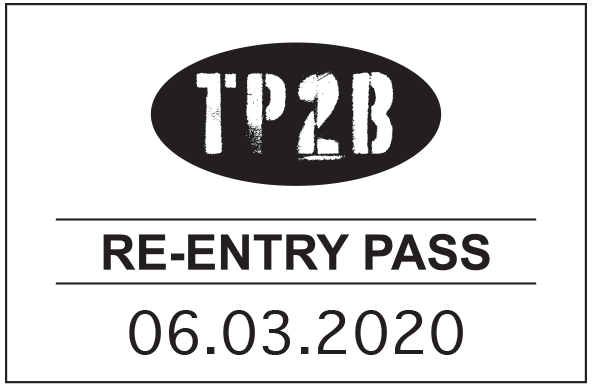Re-entry passes for licensed premises
Licensees who use networked identification (ID) scanners can also use re-entry passes. Re-entry passes allow patrons to leave and re-enter the premises during the same trading period without having their ID re-scanned.
Patrons can't re-enter a regulated premises after 10pm without first:
- having their ID verified as genuine and also scanned for cross-checking against the banned list
- or
- showing a suitable re-entry pass.
For example, if they exit temporarily to have a cigarette, when they re-enter after 10pm, they'll need to have their ID checked and scanned again or show a re-entry pass.
You can give each patron their re-entry passes the first time you scan their ID as long as they don't have banning orders for your premises.
Read more about when you must scan ID.
Suitable types of re-entry passes
A re-entry pass can be an identifying mark (e.g. a stamp), an object (e.g. a wristband) or a type of electronic identifier.
If you want to use an object or electronic identifier, contact us to discuss the suitability of your proposed re-entry system.
Re-entry stamps must be identifiable as re-entry passes and meet the following requirements.
-
The re-entry stamp design should include the name of your premises and the trading date.
The stamp can show the trading day (e.g. Friday, Saturday) instead of a date as long as you don't accept a stamp from the week before—using water soluble ink will help.
The stamp you give each patron whose ID you've scanned must be different to any stamps you give patrons before 10pm whose ID you haven't scanned. Consider using different coloured ink and adding different wording.
We will monitor the use of stamps and will consider them insufficient if we identify any issues. We won't accept a stamp that:
- hasn't been designed specifically for your premises, for example, a stamp produced in bulk and available for the public to buy
- only includes your premises' name.
-
To make sure the re-entry stamp is secure, ensure the ink can't be transferred between people without it being obvious to your staff—using fast-drying, water-soluble ink will help. Your staff should check if it looks faded.
Don't choose a stamp design where the image and premises' name are simple and easily copied or drawn. Symmetrical designs are easier to transfer from one patron to another.
The stamp should be applied to the same spot on everyone (e.g. inside the left wrist) to help avoid it being transferred or copied.
-
Only issue re-entry passes to patrons who've had their ID scanned during regulated hours (i.e. from 10pm to closing).
It's not acceptable practice to issue a stamp on exit after 10pm without first confirming the person had their ID scanned earlier. If you're not sure, scan their ID again before issuing the re-entry stamp.
Keep a written record of your re-entry pass system
You must keep a written record of the type of re-entry pass system you're using and make it available for inspection by the Office of Liquor and Gaming Regulation (OLGR) when requested.
Consider recording the following points about the daily operation of your re-entry pass system:
- how you ensure your re-entry pass is unique
- the person who decides the type of re-entry pass you use
- which date you include on your re-entry pass (i.e. the date the trading period starts or the date it ends)
- the staff who are responsible for issuing re-entry passes and checking them when patrons re-enter the premises
- when and how staff are trained in the re-entry pass system
- how patrons re-entering the premises are managed (e.g. in separate queues or at alternate entry points)
- your venue's policy for managing invalid re-entry passes or suspicions of dishonesty (e.g. scanning the patron's ID again)
- the security controls you use to prevent re-entry passes being copied or transferred by patrons.
Best practice example
The Place 2B (TP2B) is a licensed premises that operates a re-entry pass system on:
- Friday, Saturday and Sunday nights
- the eve of public holidays
- other nights during regulated hours, as determined by management.
TP2B has a single entry to the premises. A queueing area is separated by a rope running parallel to, and 1.5m from, the wall. This allows pedestrians to pass on the footpath. A separate queue is set up for re-entry.
TP2B uses a stamp as the re-entry pass. It's a self-inking stamp, using fast-drying, water-soluble red ink. It shows the premises' logo and states 're-entry pass' and the trading date.

When the re-entry system is operating TP2B ensures:
- the date on the stamp is the date the trading period starts
- re-entry stamps are only issued when the ID has been verified as genuine and scanned after 10pm
- patrons are stamped right after their ID has been verified and scanned, once it's confirmed they don't have banning orders for the premises and aren't being denied entry for another reason
- re-entry stamps are applied to patrons' inside right wrists
- no one leaving the premises is stamped without first having their ID verified and scanned
- only staff members who've been properly trained apply the re-entry stamp and check its authenticity
- they re-scan each patron's ID if there's any doubt about the validity of the stamp
- all stamps are secured by management in the office safe when not in use
- prominent signage lets patrons know stamps don't provide automatic right of entry—they may be required to re-scan their ID on re-entry at the discretion of management or the crowd controller.
Training
At induction, all staff, including crowd controllers, should be trained in your re-entry system and their roles in its operation.